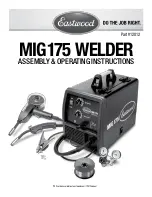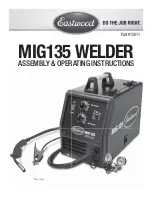
FABRICATOR 252i
BASIC WELDING
BASIC WELDING
4-6
Manual 0-5155
Wire feeding problems can be reduced by checking the following points.
FAULT
CAUSE
1 Feed roller driven by motor in the
cabinet slipped.
Wire spool brake is too tight.
2 Wire spool unwound and tangled.
Wire spool brake is too loose.
3 Worn or incorrect feed roller size.
A Use a feed roller matched to the size you are welding.
B Replace feed roller if worn.
4 Wire rubbed against the misaligned
guides and reduced wire feed ability.
Misalignment of inlet/outlet guides
5 Liner blocked with swarf.
A Increased amounts of swarf are produced by the wire passing
through the feed roller when excessive pressure is applied to the
pressure roller adjuster.
B Swarf can also be produced by the wire passing through an incor-
rect feed roller groove shape or size.
C Swarf is fed into the conduit liner where it accumulates thus
reducing wire feed ability.
6 Incorrect or worn contact tip.
A The Velocity contact tip transfers the weld current to the electrode
wire. If the hole in the contact tip is too large then arcing may
occur inside the contact tip resulting in the wire jamming in the
contact tip.
B When using soft wire such as aluminum it may become jammed
in the contact tip due to expansion of the wire when heated. A
Velocity contact tip designed for soft wires should be used.
7 Poor work lead contact to work piece.
If the work lead has a poor electrical contact to the work piece
then the connection point will heat up and result in a reduction of
power at the arc.
8 Bent liner.
This will cause friction between the wire and the liner thus reduc-
ing wire feed ability
Table 4-2: Wire Feeding Problems
Basic MIG (GMAW/FCAW) Welding Troubleshooting
FAULT
CAUSE
REMEDY
1 Undercut
A Welding arc voltage too high. A Decrease voltage or increase the wire feed speed.
B Incorrect MIG Gun angle
B Adjust angle.
C Excessive heat input
C Increase the MIG Gun travel speed and/or decrease
welding current by decreasing the voltage or
decreasing the wire feed speed.
2 Lack of penetration
A Welding current too low
A Increase welding current by increasing wire feed
speed and increasing voltage.
B Joint preparation too narrow
or gap too tight
B Increase joint angle or gap.
C Shielding gas incorrect
C Change to a gas which gives higher penetration.
3 Lack of fusion
Voltage too low
Increase voltage.
















































